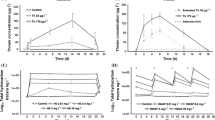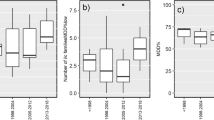Abstract
To validate the use of small indoor microcosms for the risk assessment of pesticides, the fate and effects of chlorpyrifos, carbendazim, and linuron were studied in 8.5–liter indoor freshwater microcosms. Functional and structural responses to selected concentrations were evaluated and compared with responses observed in larger-scale model ecosystem studies. Overall, the microcosms adequately displayed the chain of effects resulting from the application, although they did not always predict the exact fate and responses that were observed in larger semifield studies. Because closed systems were used that did not contain sediment and macrophytes, pesticides were relatively persistent in the present study. Consequently, calculated toxicity values were generally more comparable with those reported in studies with long- than with short-term exposure. Carbendazim had a higher overall no-observed-effect concentration (NOEC) compared with experiments performed in larger systems because macroinvertebrate taxa, the most sensitive species group to this fungicide, were not abundant or diverse. Future refinements to the test system could include the addition of a sediment compartment and sensitive macroinvertebrate taxa. However, the simple design offers the potential to perform experiments under more controlled conditions than larger and, consequently, more complex model ecosystems, while maintaining relatively high ecologic realism compared with standard laboratory tests. Further implications for risk-assessment studies are discussed in an ecotoxicologic and methodologic context.








Similar content being viewed by others
References
Beyers RJ, Odum HT (1993) Ecologic microcosms. Springer-Verlag, New York, NY
Black RW, Hairston NG (1988) Predator driven changes in community structure. Oecologia 77:468–479
Brock TCM, Crum SJH, Van Wijngaarden R, Budde BJ, Tijink J, Zuppelli A, et al. (1992) Fate and effects of the insecticide Dursban 4E in indoor Elodea-dominated and macrophyte-free freshwater model ecosystems: I. Fate and primary effects of the active ingredient chlorpyrifos. Arch Environ Contam Toxicol 23:69–84
Brock TCM, Vet JJRM, Kerkhofs MJJ, Lijzen J, Van Zuilekom WJ, Gijlstra R (1993) Fate and effects of the insecticide Dursban 4E in indoor Elodea dominated and macrophyte free freshwater model ecosystems: III. Aspects of ecosystem functioning. Arch Environ Contam Toxicol 25:160–169
Brock TCM, Lahr J, Van den Brink PJ (2000a) Ecologic risks of pesticides in freshwater ecosystems; part 1: Herbicides. Report 088. Alterra, Green World Research, Wageningen, The Netherlands
Brock TCM, Van Wijngaarden RPA, Van Geest GJ (2000b). Ecologic risks of pesticides in freshwater ecosystems; part 2: Insecticides. Report 089. Alterra, Green World Research, Wageningen, The Netherlands
Campbell PJ, Arnold DJS, Brock TCM, Grandy NJ, Heger W, Heimbach F, et al. (1999) Guidance document on higher tier aquatic risk assessment for pesticides (HARAP). SETAC-Europe/OECD/EC Workshop, Lacanau Océan, France
Crossland NO, Heimbach F, Hill IR, Boudou A, Leeuwangh P, Matthiessen P, et al. (1992) Summary and recommendations of the European Workshop On Freshwater Field Tests (EWOFFT), Potsdam, Germany
Crum SJH, Brock TCM (1994). Fate of chlorpyrifos in indoor microcosms and outdoor experimental ditches. In: Hill IA, Heimbach F, Leeuwangh P, Matthiesen P (eds) Freshwater Field Tests for Hazard Assessment of Chemicals. Lewis, Boca Raton, FL, pp 217–248
Cserhati T, Vegh A, Dobrovolszky A (1976) Study on the factors influencing the decomposition of linuron. I. The temperature and pH dependence of the linuron decomposition. Acta Phytopathologica Academiae Scie Hung 11:325–330
Cuppen JGM, Van den Brink PJ, Van der Woude H, Zwaardemaker N, Brock TCM (1997) Sensitivity of macrophyte-dominated freshwater microcosms to chronic levels of the herbicide linuron. II. Community metabolism and invertebrates. Ecotox Environ Saf 38:25–35
Cuppen JGM, Van den Brink PJ, Camps E, Uil KF, Brock TCM (2000) Impact of the fungicide carbendazim in freshwater microcosms. I. Water quality, breakdown of particulate organic matter and responses of macroinvertebrates. Aquat Toxicol 48:233–250
Cuppen JGM, Crum SJH, Van den Heuvel HH, Smidt RA, Van den Brink PJ (2002) Effects of a mixture of two insecticides in freshwater microcosms I. Fate of chlorpyrifos and lindane and responses of macroinvertebrates. Ecotoxicology 11:165–180
Fedorenko AY (1975) Feeding characteristics and predation impact of Chaoborus (Diptera, Chaoboridae) larvae in a small lake. Limnol Oceanogr 20:250–258
Flemer DA, Ruth BF, Bundrick CM, Moore JC (1997) Laboratory effects of microcosm size and the pesticide chlorpyrifos on benthic macroinvertebrate colonization of soft estuarine sediments. Mar Environ Res 43:243–263
Giesy JP, Solomon KR, Coats JR, Dixon KR, Giddings JM, Kenaga EE (1999). Chlorpyrifos: Ecologic risk assessment in North American aquatic environments. Rev Environ Contam Toxicol 160:1–129
Hanazato T (1998) Response of a zooplankton community to insecticide application in experimental ponds: A review and the implications of the effects of chemicals on the structure and functioning freshwater communities. Environ Pollut 101:361–373
Hommen U, Veith D, Dülmer U (1994). A computer program to evaluate plankton data from freshwater field tests. In: Hill IR, Heimbach F, Leeuwangh P, Matthiessen P (eds) Freshwater Field Tests for Hazard Assessment of Chemicals. Lewis, Boca Raton, FL, pp 503–513
Kersting K, Van den Brink PJ (1997) Effects of the insecticide Dursban4E (active ingredient chlorpyrifos) in outdoor experimental ditches: Responses of ecosystem metabolism. Environ Toxicol Chem 16:251–259
Kersting K, Van Wijngaarden RPA (1999) Effects of a pulsed treatment with the herbicide Afalon (active ingredient linuron) on macrophyte-dominated mesocosms I. Responses of ecosystem metabolism. Environ Toxicol Chem 18:2859–2865
Leeuwangh P, Brock TCM, Kersting K (1994) An evaluation of four types of freshwater model ecosystem for assessing the hazard of pesticides. Hum Exp Toxicol 13:888–899
Macalady DL, Wolfe NL (1983). New perspectives on the hydrolytic degradation of the organophosphorothioate insecticide chlorpyrifos. J Agric Food Chem 31:1139–1147
Maier-Bode H, Härtel K (1981). Linuron and monolinuron. Res Rev 77:3–8
Moed JR, Hallegraeff GM (1978) Some problems in the estimation of chlorophyll–a and phaeopigments from pre and postacidification spectrophotometric measurements. Int Rev Ges Hydrobiol 63:787–800
Racke KD (1993) Environmental fate of chlorpyrifos. Rev Environ Contam Toxicol 131:1–154
Sherry J (1994) Effects of 2,4-dichlorophenoxyacetic acid on fungal propagules in freshwater ponds. Environ Toxicol Water Qual 9:209–221
Slijkerman DME, Baird DJ, Conrad A, Jak RG, Van Straalen NM (2004) Assessing structural and functional plankton responses to carbendazim. Environ Toxicol Chem 23:455–462
Snel JFH, Vos JH, Gylstra R, Brock TCM (1998). Inhibition of photosystem II (PSII) electron transport as a convenient end point to assess stress of the herbicide linuron on freshwater plants. Aquat Ecol 32:113–123
Starr M, Runge JA, Therriault JC (1999) Effects of diatom diets on the reproduction of the planktonic copepod Calanus finmarchicus. Sarsia 84:379–389
Stephenson RR, Kane DF (1984) Persistence and effects of chemicals in small enclosures in ponds. Arch Environ Contam Toxicol 13:313–326
Ter Braak CJF (1995) Ordination. In: Jongman RGH, Ter Braak CJF, Van Tongeren OFR (eds) Data Analysis in Community and Landscape Ecology. Cambridge University Press, Cambridge, UK, pp 91–173
Ter Braak CJF, Smilauer P (1998) CANOCO Reference Manual and User’s Guide to Canoco for Windows. Software for Canonical Community Ordination (version 4). Centre for Biometry Wageningen, Wageningen, The Netherlands, and Microcomputer Power, Ithaca, NY
Van den Brink PJ, Van Wijngaarden RPA, Lucassen WGH, Brock TCM, Leeuwangh P (1996) Effects of the insecticide Dursban4E (active ingredient chlorpyrifos) in outdoor experimental ditches: II. Invertebrate community responses and recovery. Environ Toxicol Chem 15:1143–1153
Van den Brink PJ, Hartgers MH, Fettweis U, Crum SJH, Van Donk E, Brock TCM (1997) Sensitivity of macrophyte-dominated freshwater microcosms to chronic levels of the herbicide linuron. I. Primary producers. Ecotox Environ Safety 38:13–24
Van den Brink PJ, Ter Braak CJF (1999) Principal response curves: Analysis of time-dependant multivariate responses of a biologic community to stress. Environ Toxicol Chem 18:138–148
Van den Brink PJ, Hattink J, Bransen F, Van Donk E, Brock TCM (2000) Impact of the fungicide carbendazim in freshwater microcosms. II. Zooplankton, primary producers and final conclusions. Aquat Toxicol 48:251–264
Van den Brink PJ, Hartgers EM, Gylstra R, Bransen F, Brock TCM (2002) Effects of a mixture of two insecticides in freshwater microcosms: II. Responses of plankton and ecologic risk assessment. Ecotoxicology 11:181–197
Van den Brink PJ, Van den Brink NW, Ter Braak CJF (2003) Multivariate analysis of ecotoxicological data using ordination: Demonstrations of utility on the basis of various examples. Australas J Ecotoxicol 9:141–156
Van Geest GJ, Zwaardemaker NG, Van Wijngaarden RPA, Cuppen JGM (1999) Effects of a pulsed treatment with the herbicide afalon (active ingredient linuron) on macrophyte-dominated mesocosms. II. Structural responses. Environ Toxicol Chem 18:2866–2874
Van Wijngaarden RPA, Van den Brink PJ, Oude Voshaar JH, Leeuwangh P (1995) Ordination techniques for analyzing response of biologic communities to toxic stress in experimental ecosystems. Ecotoxicology 4:61–77
Van Wijngaarden RPA, Van den Brink PJ, Crum SJH, Oude Voshaar JH, Brock TCM, Leeuwangh P (1996) Effects of the insecticide Dursban4E (active ingredient chlorpyrifos) in outdoor experimental ditches: I. Comparison of short–term toxicity between laboratory and field. Environ Toxicol Chem 15:1133–1142
Van Wijngaarden RPA, Crum SJH, Decraene K, Hattink J, Van Kammen A (1998) Toxicity of derosal (a.i. carbendazim) to aquatic invertebrates. Chemosphere 37:673–683
Van Wijngaarden RPA, Brock TCM, Van den Brink PJ (2005) Threshold levels of insecticides in freshwater ecosystems, a review. Ecotoxicology 14:353–378
Acknowledgments
This study was supported by the Dutch Ministry of Agriculture, Nature, and Food Safety (DLO/PO research programme 416). The investigators are indebted to S. Crum and A. Matser for pesticide analysis; R. Van Wijngaarden and J. Sinkeldam for assistance in, respectively, zooplankton and phytoplankton identification; D. Van Dijk for nutrient analysis; L. Van der Pas for laboratory assistance; and T. Brock for various valuable discussions and review of the manuscript.
Author information
Authors and Affiliations
Corresponding author
Rights and permissions
About this article
Cite this article
Daam, M.A., Van den Brink, P.J. Effects of Chlorpyrifos, Carbendazim, and Linuron on the Ecology of a Small Indoor Aquatic Microcosm. Arch Environ Contam Toxicol 53, 22–35 (2007). https://doi.org/10.1007/s00244-006-0001-y
Received:
Accepted:
Published:
Issue Date:
DOI: https://doi.org/10.1007/s00244-006-0001-y




